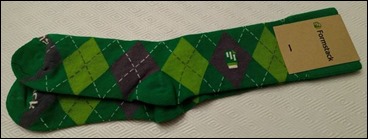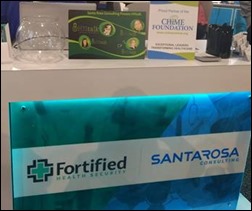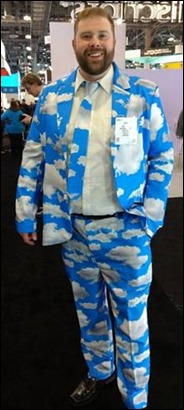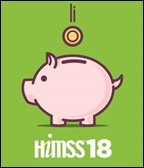EPtalk by Dr. Jayne 3/22/18
It’s been a wild week of post-HIMSS email madness, with most of the vendors that I asked to “give me a week to recover before we connect” having complied with my request. It’s a new strategy I tried this year and it seems to have worked, although a couple of companies did call or email the first business day after HIMSS.
You have to give them credit for working their leads, but one company’s contacts have bordered on the obnoxious – every two days with escalating language about our need to connect, and by both phone and email. You can bet that I’m not eager to connect with someone who doesn’t understand that people don’t always respond right away and that getting frantic about it isn’t going to build a potential business relationship.
Over the last two weeks, I’ve visited a couple of long-term clients to check in on their strategic planning for the next year. Organizations vary in how good they are at this process. Some that I’ve worked with do an outstanding job, with a major annual planning retreat each year and then quarterly or monthly follow-ups. They’re a joy to work with since they set their dates a year in advance to ensure everyone can attend and that agendas are productive, since they typically pull key provider stakeholders out of productive clinic time to meet their objectives.
Others are pretty bad at it, with last-minute attempts to pull people together and slapdash agendas. The worst don’t do any strategic planning at all and then wind up in a frenzy as they struggle to meet regulatory or other deadlines.
I was contacted by one of these organizations this week, who is looking for last-minute help with clinical quality measures reporting which is due very, very soon, as in “nine days from now” soon. I have a handful of groups reach out to me every year and all are in the same dire straits. One version of the tale of woe has the person who used to be responsible for it leaving the practice, out on medical leave, or something similar. Another version has someone running the reports regularly, but not telling anyone the numbers are bad until the end of the year and it’s too late to correct workflows. When the physicians find out, they go ballistic and I get the call. The third version has a group who knows their numbers are bad and workflows are problematic, but wants someone to “move” the data because it’s all somewhere in the EHR but just not in the right fields for reporting tools to pick it up.
I’ll help the first group as much as I can, but the rest are on their own for this reporting cycle. I’m happy to contract with the latter two to try to remediate them for next year, but I’m not going to tackle their dumpster fire (which incidentally was added to the Merriam-Webster dictionary) this year.
I enjoy reading posts by the rest of the HIStalk team, especially those that mention startups. I was baffled, however, by this piece sent to me by a reader, where startup SteadyMD refused to comment on $2.5 million in funding. Maybe they’re going for an “International Man of Mystery” vibe, but as an industry follower, it seems unusual.
![]()
In the “truth is stranger than fiction” category, I ran across this NPR piece about a reporter who had an interesting experience while working on story featuring Theranos. I’ve heard of people going off the rails during an interview, but the alleged pulling of a fire alarm to force the evacuation of a pharmacy and stop the interview is a new one.
April 16 marked Match Day, where tens of thousands of medical students are herded into auditoriums to learn their fate for the next three to five years in front of classmates and loved ones. It’s a variable experience, with some people whooping for joy and others seeing their dreams crushed. Many of us have mixed feelings about it. My medical school had a keg delivered to the auditorium lobby, so you were either celebratory or partially anesthetized by the time the envelopes were handed out.
This year’s Match set a new record, with over 37,000 applicants participating. The match results are always telling as far as physician workforce and the popularity of specialties among US medical school graduates. Programs filling with more than 90 percent US grads: interventional radiology, orthopedic surgery, integrated plastic surgery, radiation oncology, neurological surgery, and otolaryngology. The three main primary care specialties were in the “programs that filled with less than 45 percent US grads” category: family medicine, internal medicine, and primary pediatrics. The fact that US grads don’t want to go into these specialties should be very telling. Congrats to my neighbor who matched in a highly competitive specialty, even though he will be wading through lots of snow for the next six or seven years.

The highlight of my week was being on a conference line today with the funniest hold music I’ve ever heard. UberConference allows account owners to select their hold music, with one of the options being a song about being stuck on hold on a conference line. I’m sure it might have the potential to become annoying, but today it was just what I needed after having spent hours and hours on the phone yesterday. The worst hold music I’ve experienced was a current events news program that unfortunately was giving updates on a mass casualty situation that didn’t set the stage for a productive call, since participants were still in shock from what they had been hearing. The second-worst was music sounded like it was better placed in an adult film.
Apparently I’m not the only person with an interest in hold music, because a quick Internet search brought up several articles. I had forgotten the quirky Cisco default hold music – if you’re looking for an hour-long recording to jog your memory, you can find it here. I got my hopes up for an article that claimed to have 11 recordings of terrible hold music, but the links were broken so I missed out on that particular hall of shame.

Email Dr. Jayne.


























Merry Christmas and a Happy New Year to the HIStalk crowd. I wish you the joys of the season!